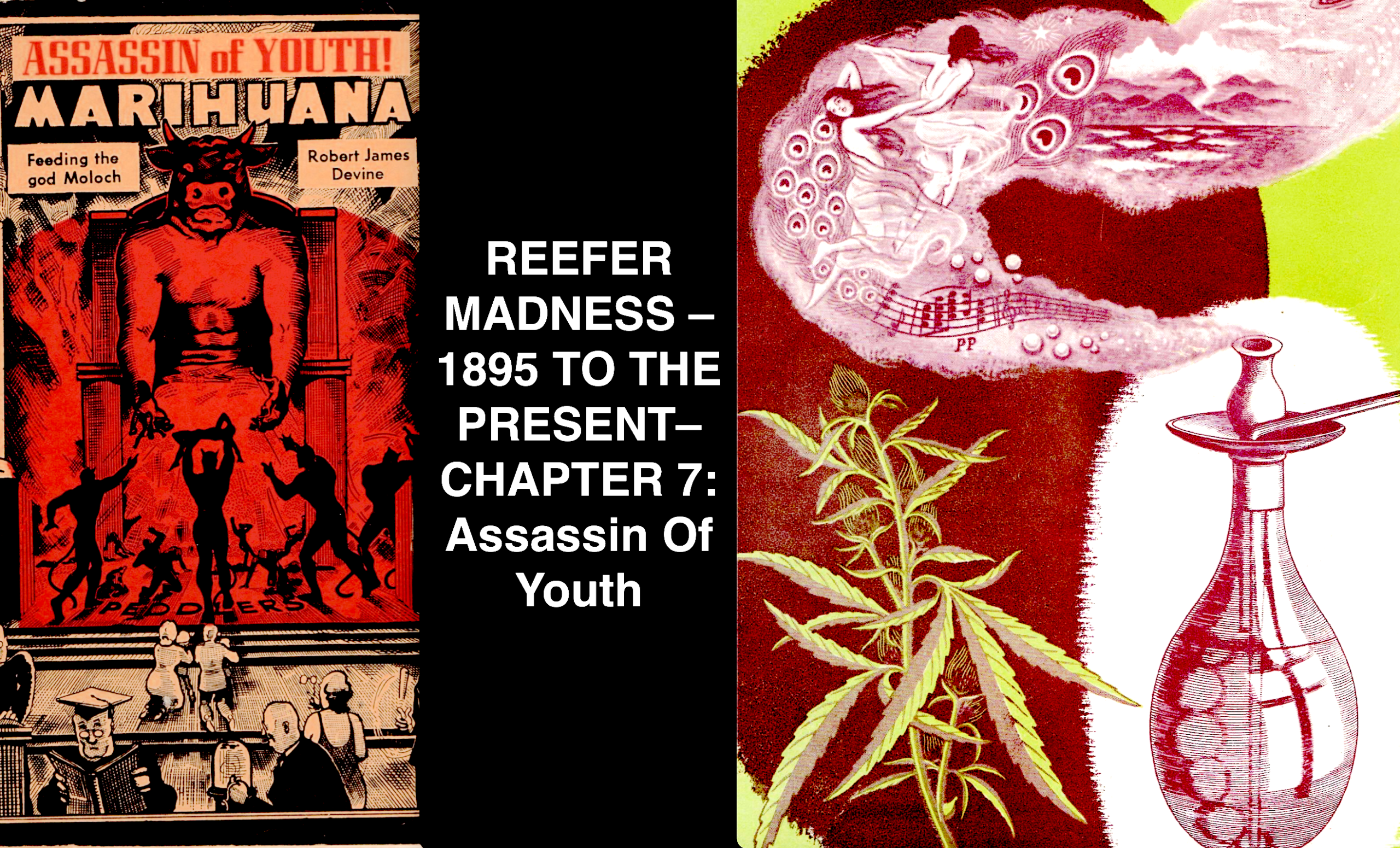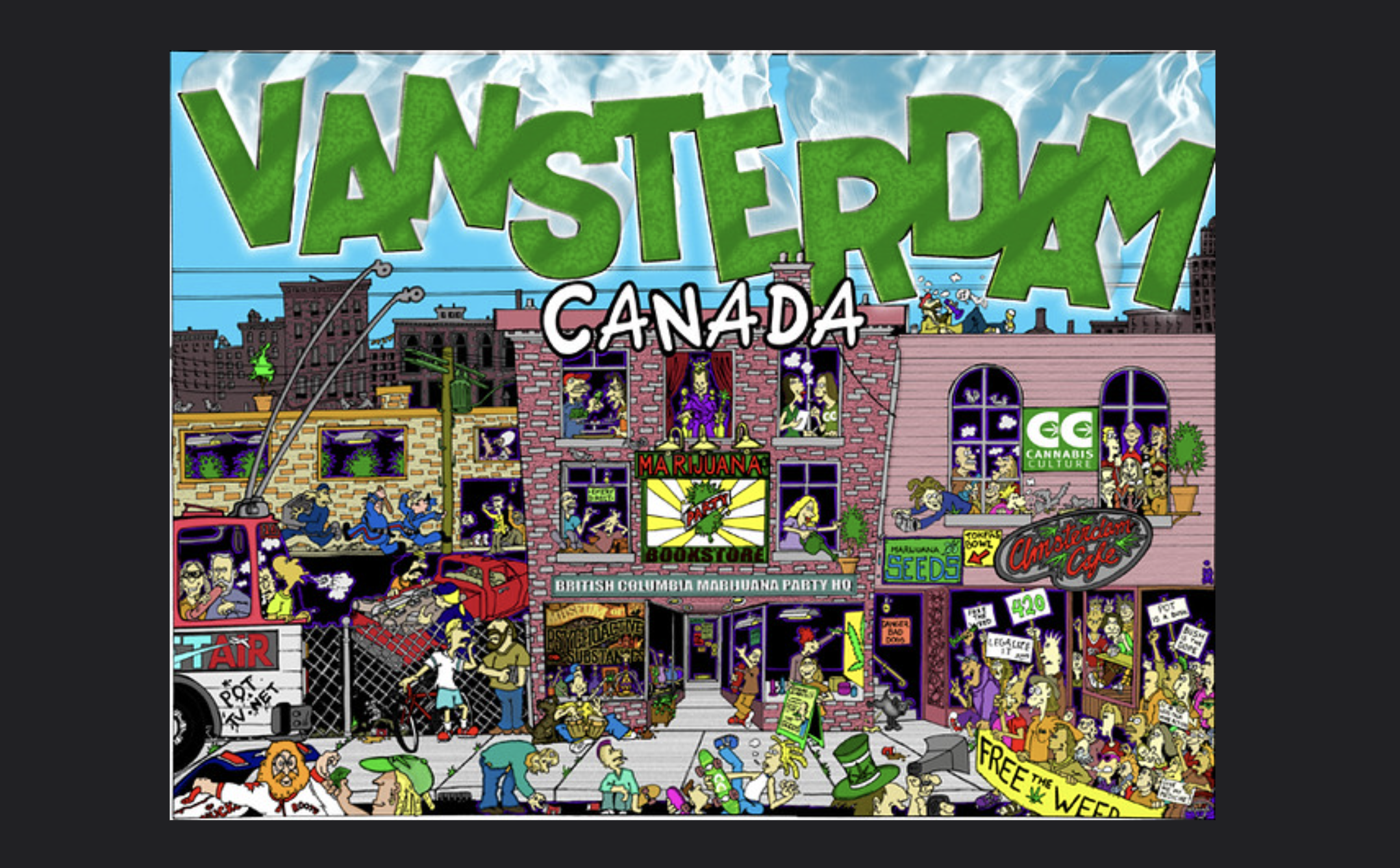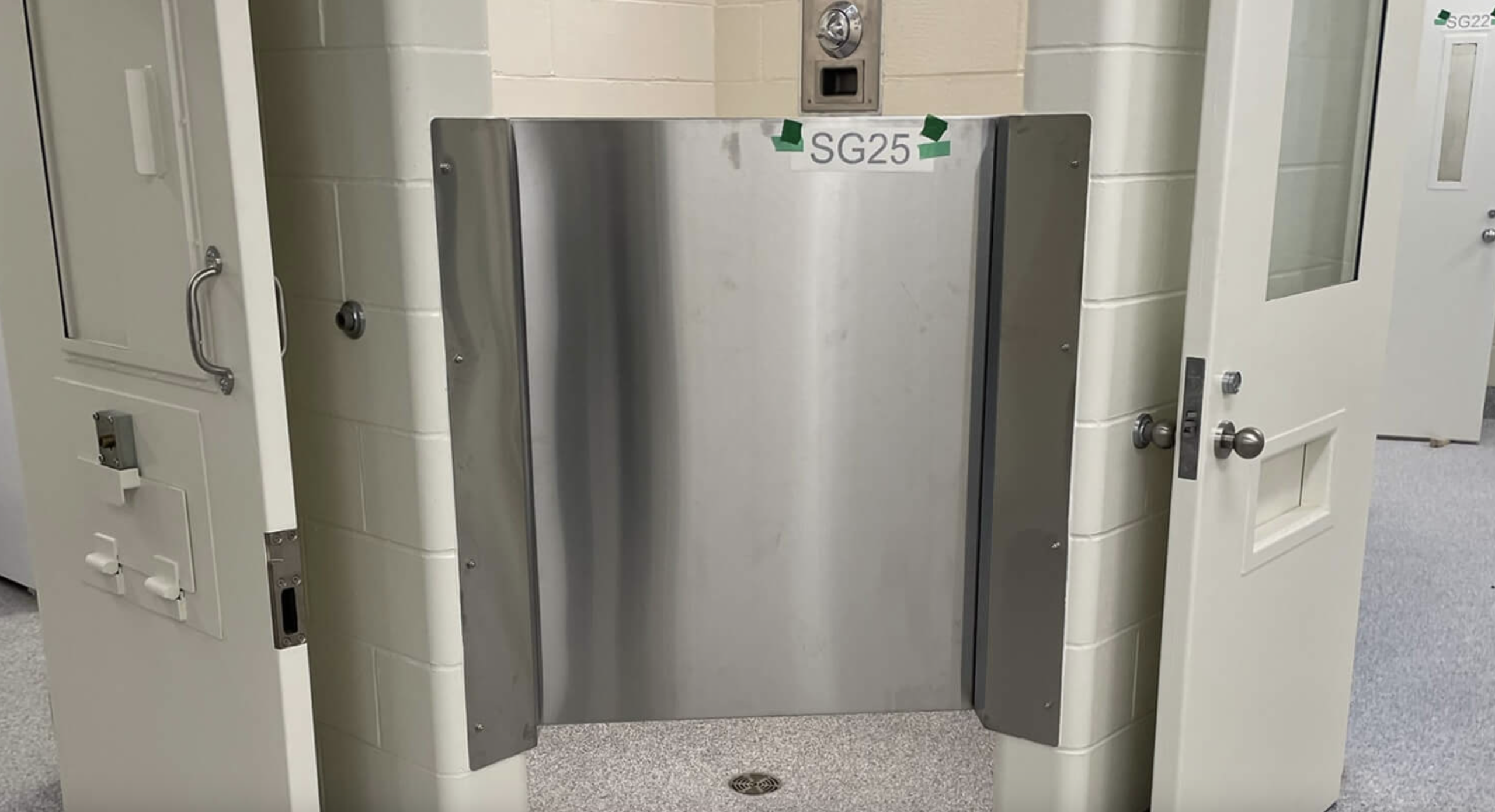We’ve Seen This Movie Before

CANNABIS CULTURE – The Reefer Madness Mythology Behind The BC Government’s Cannabis Consumption Spaces Survey.
“The Province of British Columbia regulates the sale of non-medical cannabis. Currently cannabis consumption spaces are not allowed in BC. The Ministry of Public Safety and Solicitor General is now taking a closer look at whether non-medical consumption spaces should be permitted, and if so, how they should be regulated.” (1)
Recently it was brought to my attention that the BC government was considering permitting “non-medicinal” cannabis consumption spaces, and has released a survey asking for input from the public. (2)
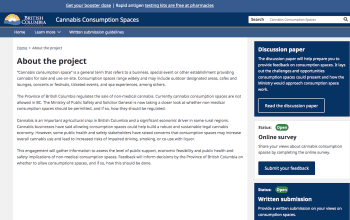 Apparently, the BC government had consulted with some legal pot industry organizations and some “safety stakeholders” back in the fall of 2021, some of whom had concerns about the negative impact of cannabis consumption spaces. (3)
Apparently, the BC government had consulted with some legal pot industry organizations and some “safety stakeholders” back in the fall of 2021, some of whom had concerns about the negative impact of cannabis consumption spaces. (3)
So now the government has decided to see what the public thinks of the idea. After one reads a short discussion paper provided (4) the BC public has been asked to either complete a survey, (5) or else provide a written submission explaining their opinion in greater detail. The government requires that submissions are sent in before May 9th 2022 at 4 pm.
Since I am all about the details, I thought I should look at the discussion paper in detail, provide analysis, and then invite readers to participate in the survey and/or the submission process themselves.
On the “Written submission guidelines” page, the government states:
“Please read the discussion paper and consider the following questions to help inform your written submissions.
- Do you agree with the principles outlined in the discussion paper? Why or why not?
- What are specific examples of cannabis consumption spaces that you would like to see allowed?
- What would make this space economically feasible as a business?
- How do you think challenges raised in this paper (for example, impaired driving) could be addressed?
- Are there types of cannabis consumption spaces that should not be considered? Why?” (6)
Most of the Reefer Madness is found within the first principle, so that is the one this writer will focus on:
- Do you agree with the principles outlined in the discussion paper? Why or why not?
The principles outlined in the discussion paper are:
- Prioritize Public Health and Safety
- Encourage Consumers to Transition to Regulated Products
- “Start Low and go Slow”
- Collaborate with Indigenous Peoples
- Respect Local Control over Land-use Decision
These seem fine on the surface, but the devil’s in the detail.
 Under “Prioritize Public Health and Safety”, the discussion paper states:
Under “Prioritize Public Health and Safety”, the discussion paper states:
“Consumption spaces should only be permitted if they are compatible with provincial public health and safety objectives, including promoting responsible use. If the Province allows consumption spaces, key public health and safety protections would continue to apply, for example, indoor smoking and vaping would not be allowed in consumption spaces.”
The assumptions that are being made here are that 1) Cannabis smoke and tobacco smoke are equally dangerous, and 2) the risk of lung cancer comes from the amount of tar, rather than the radioactive chemical fertilizers used in tobacco agriculture.
The simple fact of the matter is that cannabis smoke is not the same as tobacco smoke, and that the harm from smoking tobacco comes from the radioactive chemical fertilizers that the tobacco is grown in, not from the tobacco itself. There’s plenty of evidence of this being the case, (7) but – to my knowledge – the B.C. government and all of the health agencies under its control refuse to look at this evidence, because they would rather see smoked medicine as inherently pathological – and subject to cartel-esque distribution models – than to admit they’ve been wrong for decades about tobacco and chemical fertilizers.
If the BC government was truly interested in “Prioritizing Public Health and Safety” with regards to indoor tobacco and cannabis smoke, it would insist on heavy metal testing for tobacco and cannabis products – but neither the BC government or the Canadian government have such standards. (8)
Under “Encourage Consumers to Transition to Regulated Products” the discussion paper states:
“Consumption space policies should encourage people to transition from illicit to legal cannabis products. However, the availability of consumption spaces should not contribute to significant increases in problematic cannabis use.”
The assumptions being made here are that 1) moving from the illicit market to the legal market is a good thing, because the legal market has a higher quality product and no involvement with organized crime, and 2) there’s a thing called “problematic cannabis use” that’s a real problem and creating “consumption spaces” would make that problem bigger.
Firstly, the evidence for the assumption that the legal market has cleaner cannabis is weak to non-existant. There’s evidence to the contrary that the government refuses to look at. (9)
Secondly, the evidence that the legal market has less “organized crime” involvement than the legacy market is also debatable. The Canadian government – by allowing anonymous ownership of Licensed Producers – purposely prevented the elimination of organized crime from the legal market, in spite of warnings from advocates of reform. (10)
Thirdly, the health costs to society of problematic cannabis use – according to a website partially funded by the BC government – is 8.25 times less than alcohol and more than 40 times less than tobacco:
“In terms of costs per user: tobacco-related health costs are over $800 per user, alcohol-related health costs are much lower at $165 per user, and cannabis-related health costs are the lowest at $20 per user.” (11)
To reduce the health costs of cannabis, the BC government should consider spending money on educating people how to use cannabis properly rather than attempt to prevent its use. Cannabis harm reduction isn’t difficult to understand. (12)
Cannabis consumption sites would reduce the costs to society from cannabis abuse, as the amount of impaired driving – from people having nowhere else to smoke pot other than their cars – would be reduced by giving people a safer option.
Under “Start Low and go Slow” the discussion paper states:
“Consumption spaces should be implemented using a phased approach. This would allow regulators to learn about consumption spaces and use these experiences to inform decisions about whether or how to license other spaces. Regulators could start with lower complexity spaces or spaces where cannabis consumption is already likely to occur, such as by allowing licensed sales at music festivals, as this may help manage public safety risks like impaired driving. Special events could be used to trial different consumption spaces and learn about their impacts.”
The assumptions made here are that 1) consumption spaces have never existed before so there’s no examples to learn from, and 2) the risks worth mentioning are “impaired driving,” and it is unknown what impact consumption sites would have on impaired driving.
Firstly, the phrase “start low and go slow” when applied to cannabis harm reduction usually involves the idea of “titration” or dose control. Dose control is easier to accomplish with smoked or vaporised cannabis rather than edibles, as the time it takes to achieve the desired effect is a matter of a minute or two rather than 40 minutes or more, which allows one to more easily adjust one’s dose to achieve the desired effect. This concept has been well understood for a long time within the cannabis community. (13)
Secondly, the first true “consumption site” for cannabis in Canada was the Cannabis Café on the “pot block” in Vancouver, opened by Hemp BC in 1997. Since then, the pot block (the 200-300 West Hastings block) in has hosted at least one and as many as 4 consumption sites. Cannabis activists have had decades of experience operating these sites and can identify the true health-related and social-harmony-related concerns involved.
Regarding “impaired driving,” as was mentioned previously, having a space other than one’s car to smoke or vapourise cannabis reduces the amount of impaired driving that may occur with cannabis use. Having a place one can practice titration with peers who are familiar with titration may accelerate the speed at which proper titration is learned. As was noted by the Supreme Court of Canada in Malmo-Levine (2003) in paragraph 197 of their decision:
“. . . naive users should be careful and if they choose to smoke should do so with experienced users and in an appropriate setting . . .” (14)
All harm-reduction concepts are best understood and explained by the staff and regular customers of the unregulated consumption sites already in existence on the pot block and in other jurisdictions in BC and across Canada.
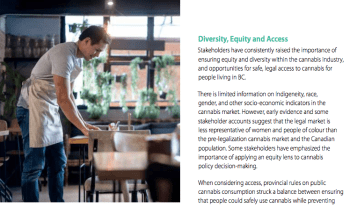 Under “Collaborate with Indigenous Peoples” the discussion paper states:
Under “Collaborate with Indigenous Peoples” the discussion paper states:
“The Province is seeking input from Indigenous peoples and individuals on cannabis consumption spaces. If the Province proceeds with cannabis consumption spaces, it is committed to working in partnership with Indigenous peoples to identify and address their interests. Some Indigenous nations and organizations involved in cannabis have already been contacted about consumption spaces. There will be opportunities for further dialogue with Indigenous nations during and after this engagement.”
This pronouncement is laughable. So far, the interactions between various levels of government and the Indigenous cannabis community has mostly consisted of dozens and of raids by the “Community Safety Unit” (BC pot cartel enforcement cops) or similar entities against indigenous-owned pot dispensaries for the benefit of the pot cartel. (15)
For any meaningful “dialogue” to begin, the raids must end, and all Indigenous cannabis retail operations must be allowed to exist unmolested.
Under “Respect Local Control over Land-use Decision” the discussion paper states:
“Under provincial cannabis legislation, local governments and Indigenous nations play a key role in determining whether and where licensed cannabis sales can take place in their communities—this approach would also apply to cannabis consumption spaces. This role ensures that surrounding land-uses and infrastructure impacts are considered (for example, considering whether a proposed consumption space has adequate transportation options to address concerns about impaired driving). Cannabis businesses that are interested in cannabis agri-tourism or hospitality opportunities located on the Agricultural Land Reserve (ALR), including cannabis consumption spaces, may also be also restricted in what non-farm use activities they can pursue.”
Firstly, given the fact that many of the raids of Indigenous dispensaries have been on land already acknowledged as Indigenous owned, this “principle” of “respect” for “local control” is as laughable as the last principle about a “partnership” between those who raid and those who get raided.
Secondly, there is an assumption within the above principle that cannabis impairment is inherent and not a function of dose and familiarity. The evidence suggests otherwise. (16)
As for part 2 and part 3 of the written submission questions, the cannabis community is in favour of bringing into existence the types of consumption sites that have existed informally in BC for decades, and in Holland since the late 1960s. Take, for example, this description of a consumption site in Amsterdam in 1969:
“There are only two clubs in the West where hashish may be smoked with police consent and the benevolent subsidy of the local government. Both are in Amsterdam. Here is an uncensored report on a wanton Saturday night in the most uninhibited of the two, Fantasio Youth Club: First you push open a door in an otherwise nondescript house facing the docks, and you join the queue for becoming a member of Fantasio (price 84 cents). An incoming tide of youngsters presses you up the stairs to a spacious loft . . . By 10 p.m. the room is pullulating with scruffy patrons, many of them looking like the case of the New York musical ‘hair’. … During the evening, by rough estimate, about a third of the 300 or 400 youngsters were smoking hashish, and were lost in their private nebulae. Another third were drinking Dutch beer and moving restlessly from room to room of the club, presumably looking for something to happen somewhere. … Fantasio and its sister club, Paradiso, were opened last April in a conscious effort to try a new approach to the problem of cannabis – the approach of total permissiveness … Both clubs have the same fundamental rule. Hashish is permitted but the hard stuff is out. Fantasio, unlike the adult-controlled Paradiso, is run completely by the youngsters themselves.” (17)
This type of site – where young people have a safe place to smoke and peers to learn from – is exactly the type of smoking and vapour lounges the BC government has explicitly expressed no desire to create.
The rest of the discussion paper is filled with assumptions that are equally erroneous.
 Under the heading “Increased Rates of Cannabis Use” the discussion paper states:
Under the heading “Increased Rates of Cannabis Use” the discussion paper states:
“Consumption spaces could provide greater public access and exposure to cannabis, leading to increased cannabis-use rates and negative health and safety outcomes.”
The assumption is that cannabis is a hard drug and a vice and – like alcohol and tobacco – increased use will always lead to increased abuse.
The fact is that cannabis is a soft drug – no more damaging to humans than coffee beans (18) or other herbal medicine.
Furthermore, there are harm reduction techniques for alcohol and tobacco that the BC government and all its agencies are oblivious to. For example, tobacco could be grown organically and smoked in rituals of moderation or with traditional, lung-cleaning herbal smoking mixtures called kinnickinnick. Many of these herbs have strong medicinal powers that benefit the lungs. (19) Alcohol could be sold as a liquid depressant that acts as a euphoric in small doses rather than an aphrodisiac (as it is depicted in many beer and wine commericals).
And cannabis is a medicine when used properly, and also a substitute for harder drugs. The more proper cannabis use occurs, the less likely hard drug use occurs. Again, the BC government seem determined to ignore the massive pile of evidence of this being the case. (20)
The document is filled with sentences that try to frame cannabis as a hard drug, such as “it will be important to consider appropriate mitigations to minimize child and youth exposure to cannabis consumption” and “provincial rules on public cannabis consumption struck a balance between ensuring that people could safely use cannabis while preventing non-medical cannabis use in places where children tend to gather” and “Individuals must be 19 years or older to buy, use, or grow cannabis in BC” – apparently to “protect children and youth”.
But prohibiting young people from accessing cannabis doesn’t protect them. Teens don’t respect or obey their new cannabis prohibition under “legalization” any more than they respected the old cannabis prohibition. (21)
If the BC government really cared at all about “protecting children and youth” they would not restrict youth access to cannabis, but rather follow the recommendations of the Senate Report of 2002, which recommended the government allow teens 16 and over legal access – to protect teens from the harms that come with prohibition. (22) Allowing teens access to legal cannabis would help mitigate what teens are actually dying from – suicide, drug and alcohol overdoses, and car crashes from drunk driving. (23)
There is zero evidence of cannabis harming teens when used properly – and there is ample evidence to the contrary – more evidence the BC government doesn’t want to admit exists. (24) Teens have proven to be an important part of the BC cannabis culture, (25) and deserve all the benefits and safety that legalization provides adults.
In conclusion, the BC government’s Cannabis Consumption Spaces Survey is filled with baseless assumptions and unrealistic, fact-free biases. Until the BC government and the agencies it supports begin to understand cannabis as a beneficial medicinal herb, a soft recreational drug and a medicine for healthy people – rather than a “non-medical” vice – there will be no progress in cannabis policy. Until that day, such discussion papers will continue to serve as an example of what lengths establishment academics and politicians can go to in the attempts of trying to sell their “cannabis is a hard drug” pro-pot-cartel BS as reality.

Citations
1) “Cannabis Consumption Spaces – About the project” https://engage.gov.bc.ca/cannabisconsumptionspaces/about-the-project/
2) Ibid.
3) https://engage.gov.bc.ca/cannabisconsumptionspaces/process/
4)https://engage.gov.bc.ca/app/uploads/sites/741/2022/04/8711_Cannabis_Consumption_Discussion_Paper_PSSG_v5.pdf
5) https://feedback.engage.gov.bc.ca/636867?lang=en
6) https://engage.gov.bc.ca/cannabisconsumptionspaces/written-submission-guidelines/
7) “Big Tobacco knew radioactive particles in cigarettes posed cancer risk but kept quiet,” September 27, 2018
http://pot-facts.ca/big-tobacco-knew-radioactive-particles-in-cigarettes-posed-cancer-risk-but-kept-quiet/
“Pot SMOKING helps prevent lung cancer,” June 12, 2017
http://pot-facts.ca/pot-smoking-helps-prevent-lung-cancer/
“Chemical fertilizers are radioactive and the real cause of tobacco-related cancer,” April 11, 2017
http://pot-facts.ca/chemical-fertilizers-are-radioactive-and-the-real-cause-of-tobacco-related-cancer/
8) “There are currently ‘no legal limits to heavy metal content in either cannabis or tobacco in Canada,’” April 15, 2017
pot-facts.ca/there-are-currently-no-legal-limits-to-heavy-metal-content-in-either-cannabis-or-tobacco-in-canada/
9) “LP Soil Scandal?” David Malmo-Levine, November 10, 2021
https://www.cannabisculture.com/content/2021/11/10/lp-soil-scandal/
“Corporate cannabis companies Haven St. and Agro-Greens supplied Canadians with mouldy gummies,” February 6, 2021
http://pot-facts.ca/corporate-cannabis-companies-haven-st-and-agro-greens-supplied-canadians-with-mouldy-gummies/
“Licensed Producers poisoned their pot with ‘gas chamber poison’ – 28 different times!” December 2, 2019
http://pot-facts.ca/licensed-producers-poisoned-their-pot-with-gas-chamber-poison-28-different-times/
“Canopy CEO has a ‘misunderstanding’ on quality control issue 3 different ways – media only calls him on 1 way,” June 6, 2019
http://pot-facts.ca/canopy-ceo-has-a-misunderstanding-on-quality-control-issue-3-different-ways-media-only-calls-him-on-1-way/
“Dispensary cannabis is safer than LP cannabis,” September 25, 2018
https://pot-facts.ca/dispensary-cannabis-is-safer-than-lp-cannabis/
“Health Canada and the Licensed Producers have both hidden dangerous cannabis contamination from the public,” September 9, 2017
https://pot-facts.ca/health-canada-and-the-licensed-producers-have-both-hidden-dangerous-cannabis-contamination-from-the-public/
10) “The Canadian Senate created a loophole that allowed mobsters to invest in LPs,” January 28, 2019
https://pot-facts.ca/the-canadian-senate-created-a-loophole-that-allowed-mobsters-to-invest-in-lps/
11) “Cannabis, Tobacco and Alcohol Use in Canada Comparing risks of harm and costs to society,” Gerald Thomas, Chris Davis Reprinted from the “Cannabis” issue of Visions Journal, 2009, 5 (4), p. 11
https://www.heretohelp.bc.ca/cannabis-tobacco-and-alcohol-use-canada
12) “Cannabis harm-reduction concepts are not difficult to understand,” April 11, 2017
https://pot-facts.ca/cannabis-harm-reduction-concepts-are-not-difficult-to-understand/
13) “Starting with a small amount and gradually increasing the dose is the key to avoiding unwanted mental side effects. This is called titration- self-titration if adjusted by the user.”
Safe Use of Cannabis by Tod H. Mikuriya, M.D. http://druglibrary.org/schaffer/hemp/safeuse.htm
“An experienced cannabis smoker can titrate and regulate dose to obtain the desired acute effects and to minimize undesired effects.”
“Medicinal cannabis: Rational guidelines for dosing,” Gregory T Carter, Patrick Weydt, Muraco Kyashna-Tocha & Donald I Abrams, IDrugs 2004 7(5):464-470
https://www.coscc.org/wp-content/uploads/2015/08/Abrams-Medicinal-Cannabis-Rational-Guidelines-for-Dosing-.pdf
14) R. v. Malmo-Levine; R. v. Caine, 2003-12-23
https://scc-csc.lexum.com/scc-csc/scc-csc/en/item/2109/index.do
15) “Pot shop raided again,” JUNE 27, 2020
“Indigenous pot store once again target of Community Safety Unit”
https://dispensingfreedom.com/2020/06/27/pot-shop-raided-again/
“Pot shop on Tsleil-Waututh land raided,” DECEMBER 21, 2019
https://dispensingfreedom.com/2019/12/21/pot-shop-on-tsleil-waututh-land-raided/
“Confirmed Raids on Indigenous Dispensaries since Canadian legalization,” DECEMBER 3, 2019
https://dispensingfreedom.com/2019/12/03/confirmed-raids-on-indigenous-dispensaries-since-canadian-legalization/
208 search results for “Raid”
https://dispensingfreedom.com/?s=Raid
“From Under The Influence with Marijuana Man: Keeping the Community Safe…One Raid at a Time!!!” October 23, 2019
https://pot.tv/video/2019/10/23/from-under-the-influence-with-marijuana-man-keeping-the-community-safe-one-raid-at-a-time/
“Anishinabek Police Services Raid Wahnapitae Cannabis Dispensaries,” September 19, 2019
https://pot.tv/video/2019/09/19/anishinabek-police-services-raid-wahnapitae-cannabis-dispensaries/
16) “Ross Rebagliati won the first speed snowboarding gold medal on more than 8 times the ‘legal limit’ of THC in the bloodstream,” October 14, 2018
http:// pot-facts.ca/ross-rebagliati-won-the-first-speed-snowboarding-gold-medal-on-more-than-8-times-the-legal-limit-of-thc-in-the-bloodstream/
“Med pot legalization results in an average of a 10% reduction in traffic fatalities,” June 8, 2018
http://pot-facts.ca/med-pot-legalization-results-in-an-average-of-a-10-reduction-in-traffic-fatalities/
“Increases in marijuana-related car crashes is a result of changes to testing protocol,” June 8, 2018
“Increases crash odds: THC: 5%, penicillin: 25%, Legal Alcohol levels: 293%,” September 22, 2017
http://pot-facts.ca/increases-crash-odds-thc-5-penicillin-25-legal-alcohol-levels-293/
“Legalization does not lead to more deaths from car crashes,” September 16, 2017
http://pot-facts.ca/legalization-does-not-lead-to-more-deaths-from-car-crashes/
“It turns out that smoking marijuana may actually make you a safer driver,” April 18, 2017
http://pot-facts.ca/it-turns-out-that-smoking-marijuana-may-actually-make-you-a-safer-driver/
“Studies that factor-in alcohol and demographics found NO INCREASED RISK related to driving after cannabis use,” April 13, 2017
http://pot-facts.ca/studies-that-factor-in-alcohol-and-demographics-found-no-increased-risk-related-to-driving-after-cannabis-use/
“Cannabis impairment is less severe than impairment from LEGAL alcohol use levels,” April 13, 2017
http://pot-facts.ca/cannabis-impairment-is-less-severe-than-impairment-from-legal-alcohol-use-levels/
17) “Amsterdam Hashish Club Just Big Bore”, San Antonio Express, April 29th, 1969, p. 25, see also “The limits of permissiveness”, The Boston Globe, October 12th, 1969, p. 247-316
18) “Caffeine is more dangerous than cannabis in every major category of risk,” April 11, 2017
http://pot-facts.ca/caffeine-is-more-dangerous-than-cannabis-in-every-major-category-of-risk/
“Cannabis vs Caffeine: Which is Safer, a Cup of Coffee or a Puff of Weed?” David Malmo-Levine, April 20, 2016
https://www.cannabisculture.com/content/2016/04/20/cannabis-vs-caffeine-which-is-safer-a-cup-of-coffee-or-a-puff-of-weed/
19) https://en.wikipedia.org/wiki/Kinnikinnick
20) “It is important to note that emerging evidence demonstrates that many patients are turning to cannabis to safely and effectively reduce and/or replace synthetic antidepressants after having grown tired of the negative side effects associated with their use. For example, in examinations of 2,480 California patients, Dr. Mikuriya found that 27% reported using cannabis for “mood disorders” and another 5% used cannabis as a substitute for more toxic drugs (Gieringer, 2002). A recent survey of doctors in California found “that many of their patients were able to decrease their use of … antidepressant, antianxiety, and sleeping medications, or else they use cannabis to treat their side effects of jitteriness or gastrointestinal problems in order to stay on their medications” (Holland, 2010, p. 285).”
“A Brief History of the Use of Cannabis as an Antidepressant and Stimulant,” David Malmo-Levine and Rob Callaway, M.A., 2012
https://www.academia.edu/11761666/A_Brief_History_of_the_Use_of_Cannabis_as_an_Antidepressant_and_Stimulant
https://www.stressedanddepressed.ca/booklets-forms-and-downloads/
“. . . legalization is associated with a nearly 9 percent decrease in traffic fatalities, most likely to due to its impact on alcohol consumption. Our estimates provide strong evidence that marijuana and alcohol are substitutes.”
IZA DP No. 6112: Medical Marijuana Laws, Traffic Fatalities, and Alcohol Consumption D. Mark Anderson, Daniel I. Rees published in: Journal of Law and Economics, 2013, 56 (2), 333-369
https://www.iza.org/publications/dp/6112/medical-marijuana-laws-traffic-fatalities-and-alcohol-consumption
“Researchers at Columbia University’s Mailman School of Public Health found an 11 percent reduction in traffic fatalities on average when examining places that have enacted medical-marijuana laws — 23 states and the District of Columbia. The presence of medical-marijuana dispensaries also correlated with fewer traffic fatalities, the study found. Silvia Martins, a physician and associate professor who was the study’s senior author, theorized that lower traffic fatality rates in states with marijuana laws might be related to lower levels of alcohol-impaired driving as people, especially younger people, substitute weed for booze.”
“Mellow drivers? Study says states with medical-marijuana laws have lower traffic fatality rates.” December 20, 2016
https://www.washingtonpost.com/news/tripping/wp/2016/12/20/mellow-drivers-study-says-states-with-medical-marijuana-laws-have-lower-traffic-fatality-rates/
“Young people are switching from alcohol to cannabis May 4, 2017
http://pot-facts.ca/young-people-are-switching-from-alcohol-to-cannabis/
“Pot instead of opiates? Total substitution success rate 25% – partial substitution success rate 75%-97%,” October 8, 2017
http://pot-facts.ca/pot-instead-of-opiates-total-substitution-success-rate-25-partial-substitution-success-rate-75-97/
“Cannabis might serve as substitute for illicit opioids, UBC study shows,” Calgary Herald, Calgary, Alberta, December 17th, 2019, p. A5
In the years after cannabis legalization the trend in a decrease in driving deaths each and every year continued, perhaps a result of less road rage and speeding from cannabis being used as an anti-depressant and relaxant, or perhaps because of less drunk driving as a result of cannabis being used as a substitute for alcohol:
“In 2019, police reported 66 incidents of impaired driving causing death, compared with 105 the previous year. The former is the lowest number of incidents of impaired driving causing death since comparable data were first collected in 1986.”
“Impaired driving in Canada, 2019,” Samuel Perreault, Canadian Centre for Justice and Community Safety Statistics, July 15, 2021
https://www150.statcan.gc.ca/n1/pub/85-002-x/2021001/article/00012-eng.htm
21) “Additionally, past year use was unchanged in the post legalization year for all grades but increased slightly for younger youth in grades seven to nine, from 6% in 2016–17 to 7% in 2018–2019 (Health Canada, 2019).”
“Youth Cannabis use and Legalization in Canada – Reconsidering the Fears, Myths and Facts Three Years In,” Rebecca J Haines-Saah, Benedikt Fischer, J Can Acad Child Adolesc Psychiatry. 2021 Aug; 30(3): 191–196.
https://www.ncbi.nlm.nih.gov/pmc/articles/PMC8315217/
22) “CANNABIS: OUR POSITION FOR A CANADIAN PUBLIC POLICY REPORT OF THE SENATE SPECIAL COMMITTEE ON ILLEGAL DRUGS,” CHAIR PIERRE CLAUDE NOLIN DEPUTY CHAIR COLIN KENNY SEPTEMBER 2002, p. 624 https://chodarr.org/sites/default/files/chodarr0335.pdf https://www.druglibrary.org/schaffer/library/studies/canadasenate/table_of_contents.htm https://chodarr.org/search/node/Senate http://publications.gc.ca/site/eng/246855/publication.html 19) Ibid, SUMMARY REPORT, p. 52 https://sencanada.ca/content/sen/Committee/371/ille/rep/summary-e.pdf
23) “Teens need legal access to pot cafes to help avoid drunk driving, suicide and drug overdoses,” April 12, 2017
http://pot-facts.ca/teens-need-legal-access-to-pot-cafes-to-help-avoid-drunk-driving-suicide-and-drug-overdoses/
24) “Multiple reports indicate no rise in psychosis accompanies increases in pot use rates,” January 6, 2019
“Teen Marijuana Use Not Linked to Later Depression, Lung Cancer, Other Health Problems, Research Finds,” June 23, 2017
https://pot-facts.ca/teen-marijuana-use-not-linked-to-later-depression-lung-cancer-other-health-problems-research-finds/
“After controlling for potential confounding variables such as alcohol, tobacco, and hard drug use, socioeconomic status, whether the young men had health insurance, and early health status (prior to marijuana use), findings from this sample indicated that chronic marijuana users were not more likely than late increasing users, adolescence-limited users, or low/nonusers to experience several physical or mental health problems in their mid-30s. In fact, there were no significant differences between marijuana trajectory groups in terms of adult health outcomes, even when models were run without controlling for potential confounds. This is particularly striking given that men in the early onset chronic group were using marijuana (on average) once per week by late adolescence and continued using marijuana approximately 3– 4 times a week from age 20 to 26 years.” “Chronic Adolescent Marijuana Use as a Risk Factor for Physical and Mental Health Problems in Young Adult Men,” Jordan Bechtold, University of Pittsburgh School of Medicine, Theresa Simpson and Helene R. White, Rutgers University, Psychology of Addictive Behaviors, © 2015 American Psychological Association, August 3rd, 2015, Vol. 29, No. 3, 552–563, p. 557
https://www.apa.org/pubs/journals/releases/adb-adb0000103.pdf
25) “4/20 – the Teen Pot Holiday,” David Malmo-Levine, March 29, 2022 https://www.cannabisculture.com/content/2022/03/29/4-20-the-teen-pot-holiday/

